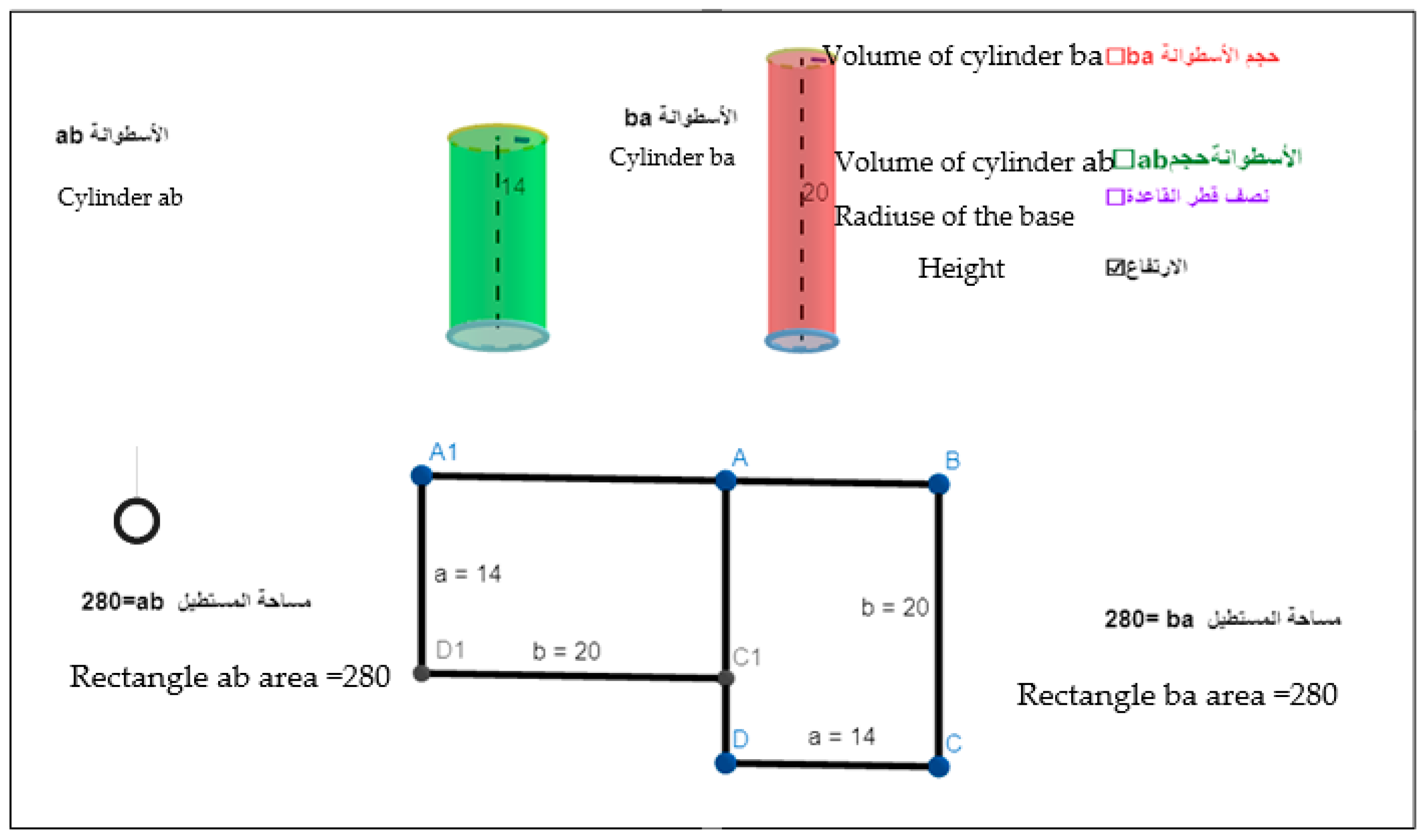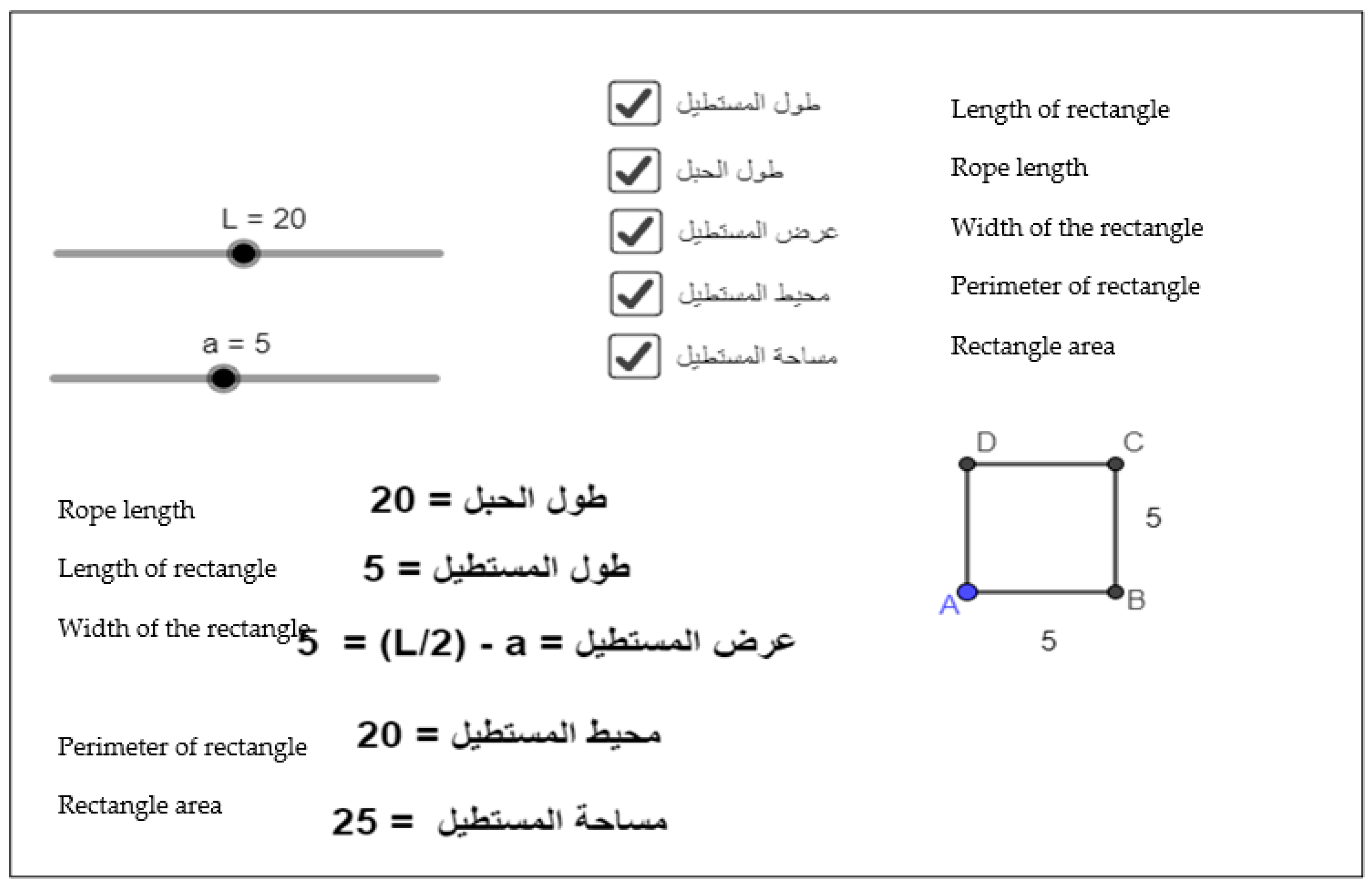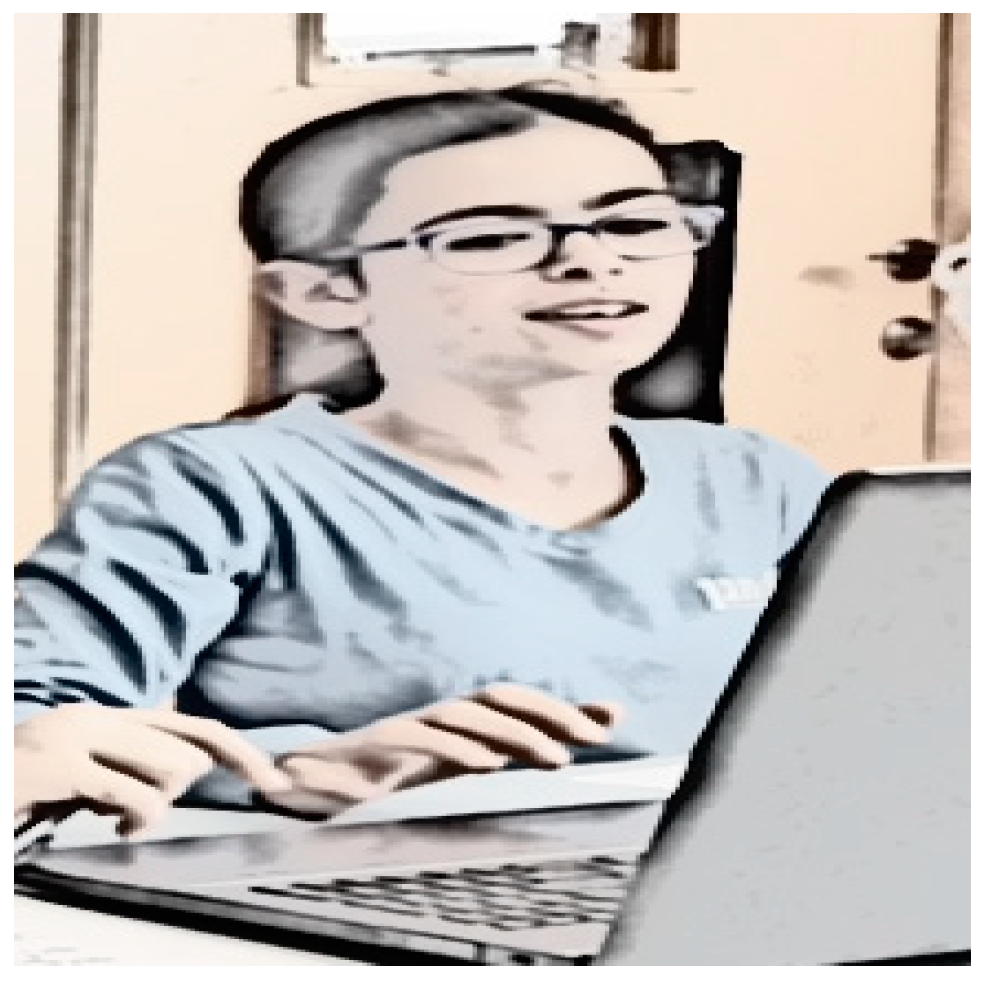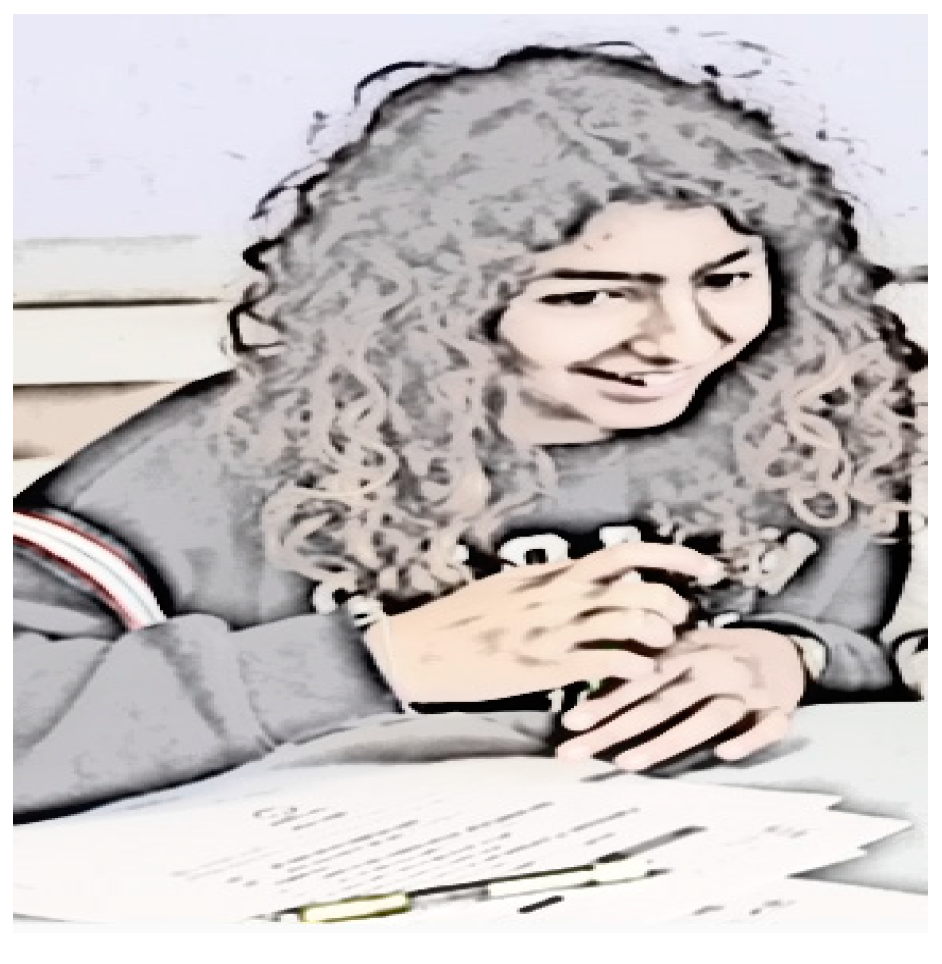Cognitive Conflict in Technological Environment: Cognitive Process and Emotions through Intuitive Errors in Area, Perimeter and Volume
Abstract
1. Introduction
2. Theoretical Background
2.1. Intuitive Errors
2.2. Cognitive Conflict
2.3. Emotions among Learning
2.4. Technology in Teaching Mathematics
3. Research Goal and Questions
- What are the characteristics of the cognitive processes that appear when students interact with activities in a technological environment related to intuitive errors?
- What are the students’ emotions’ characteristics during the emergence and overcoming of the intuitive errors in a technological environment?
4. Method
4.1. Participants
4.2. Procedure
4.3. The Chocolate Molds Activity
4.3.1. Activity Context
4.3.2. Task 1
4.3.3. Task 2
4.3.4. Task 3
4.4. Data Sources
4.5. Data Analyses
5. Finding
5.1. Cognitive and Emotion Processes during the Intuitive Error in the Three Tasks
- (5) Adam: I think the amount of the chocolate will be the same in the two cylinders; We made them by the same rectangle (looks to the other students in the group)
- (7) Ahmad: it will be the same amount (with his eyes on the computer screen, and shakes his head); in one case it will be thin or wide, but the same amount.
- (21) Ahmad: Yeah, look how…, the cylinders (while the applet builds the cylinders)
- (105) Adam: the same rope is the same circumference; the cups cover the shape we Produce (in a confident tone)
- (107) Ahmad: the number of the cups is the area (looking to other students with comfortable and confident tone)
- (109) Ahmad: Sure, it is equal, the rope has not changed. I am sure
- (111) Adel: We can frame different shape, but it still the same rope; yes I think so (shakes his head)
- (112) Ahmad: it is the same circumference in all shapes, maybe sometimes we need to divide the cups, it will not be a whole number
- (113) Adam: it did not matter, you will have the complementing parts
- (206) Mohammed: how we know, we do not have the dimensions of the cup or the box
- (207) Rami: it does not matter; we know that the cup has equal lengths
- (208) Sameer: we do the same process increased four sides and increased four sides by quarter.
- (209) Rami: I think the seam extended and curtailed in the same mount
- (210) Mohammed: I think we will have errors like the other activities we did (smiles)
- (211) Rami: I think no; this time, they are equal. (shakes his head with confident tone)
5.2. Cognitive Processes and Emotions during Revealing the Intuitive Errors in the Three Tasks
- (83) Ahmad: Ha; the size is not the same thing? (with a surprised tone) (see Figure 2)
- (84) Adam: what? 102? 56? (he means the volume of the cylinders; he talks with a surprised tone)
- (85) Adel: However, how? why are they different? (he means the cylinders’ volume, he looks at the other students and talks in a low and sad tone)
- (86) Ahmad: How this happen, it the exact dimensions (he points to the computer screen)
- (87) Adel: The same rectangle. Each time we rounded differently; why the volume different.
- (155) Ahamd: It is different! (with a surprised tone, deeply looking at the screen computer and then to other students) (see Figure 3)
- (156) Adam: oh, all of them! (with a surprised tone), they (the different rectangle) not equal
- (157) Ahmed: Haa, it means we are wrong (knocks with his hand on the table).
- (158) Adel: uh, may we try a different length of the rope? (with a non-confident tone)
- (159) Ahmed: Ok; I changed (changed the rope length)
- (160) Adel: uh, it does not matter; the area is not equal (with a surprised tone)
- (161) Adam: It is different; all of them (rectangles).
- (210) Adam: it is impossible to be wrong (deeply looking at the computer screen (see Figure 4)
- (211) Adel: it is different in all of them (with a surprised tone)
- (213) Ahmad: I do not understand (with an uncomfortable tone)
5.3. Cognitive Processes and Emotions during Overcoming Intuitive Errors in the Three Tasks
- (101) Adel: always the volumes are different (indicates to computer screen and then looks to the other students)
- (103) Adam: the thin one is always smaller (the volume of the thin cylinder is smaller than the wide one)
- (104) Adel: the radius here (the thin cylinder) is smaller than this (the wide cylinder)
- (105) Ahmad: Ahh, the area here is bigger (the bases of the wide cylinder, with loud tone)
- (106) Adam: but here (the thin cylinder), the highest is bigger
- (107) Ahmad: but the radius we squired! (in confident tone talking to Adam)
- (109) Adam: Ah, this will affect more in the volume (with a smile)
- (170) Muhammad: Compare this rectangle and this rectangle. Sure, that they will not have the same area.
- (171) Rami: why you are sure? (looks to Muhammed)
- (172) Sameer: It is so thin (indicating one of the rectangles) it will include a small Number of cups, but here (another rectangle), it will include more
- (174) Muhammed: Yes, it is clear (shakes his head)
- (176) Rami: look, it is the biggest area (with a confident tone)
- (177) Muhammed: it is square; try another length (request from Rami)
- (178) Rami: you see (produced different rectangles) the biggest is the square
- (181) Sameer: always the square is the biggest area for the same circumference
- (182) Rami: I think it is logic (shakes his head); if we closed the sides, there would be a small area. The square is the shape that we keep each of the parallel sides with the same distance.
- (183) Muhammed: Yes, so it includes more units (with a confident tone)
- (184) Rami: it is means the same area.
- (262) Lean: how much it smaller, it is different each time (serious tone)
- (263) Noor: the difference is to do subtraction between them
- (265) Maise: in all the cases, it is the same number, look here (the difference between the volume), Ah, it always the same (opens her mouth)
- (266) Noor: yes, it does not matter the dimensions. It always the same result (shakes his head)
- (268) Maise: I think it because always the multiplication of these sides (the one which was extended, and the one which was reduced)
- (269) Noor: Ah, look this (the side that is constant) and always the multiplication of these sides are 15\16 (loud tone)
- (270) Maise: it misses 1\16, so it always smaller 1\16
- (272) Lean: yes, it does not matter what the sides are
- (273) Maise: but it is a quarter?
- (274) Noor: may we can try fifth (short pause) it 1\25 smaller
- (275) Maise: May try sixth? (with an excited tone)
- (276) Noor: it is 1\36
- (277) Maise: I think seventh is 1\49 (excited tone and smiling)
- (278) Lean: OHH, yes. We found the method! (knocks on the table with smiling)
6. Discussion
7. Implication
Funding
Institutional Review Board Statement
Informed Consent Statement
Conflicts of Interest
References
- Stavy, R.; Tirosh, D. How Students (Mis-) Understand Science and Mathematics: Intuitive Rules; Teachers College Press: New York, NY, USA, 2000. [Google Scholar]
- Babai, R.; Brecher, T.; Stavy, R.; Tirosh, D. Intuitive interference in probabilistic reasoning. Int. J. Sci. Math. Educ. 2006, 4, 627–639. [Google Scholar] [CrossRef]
- Shahbari, J.A.; Peled, I. Resolving cognitive conflict in a realistic situation with modeling characteristics: Coping with a changing reference in fractions. Int. J. Sci. Math. Educ. 2014, 13, 891–907. [Google Scholar] [CrossRef]
- Dreyfus, A.; Jungwirth, E.; Eliovitch, R. Applying the “cognitive conflict” strategy for conceptual change: Some implications, difficulties and problems. Sci. Educ. 1990, 74, 555–569. [Google Scholar] [CrossRef]
- Ng, L.K. Mathematics anxiety in secondary school students. In Proceedings of the 35th Annual Conference of the Mathematics Education Research Group of Australasia, Singapore, 2–6 July 2012; pp. 570–577. Available online: http://repository.nie.edu.sg/jspui/bitstream/10497/14387/1/MERGA-2012–570-NgLK_a.pdf (accessed on 15 January 2021).
- Suárez-Pellicioni, M.; Núñez-Peña, M.I.; Colomé, A. Mathematical anxiety effects on simple arithmetic processing efficiency: An event-related potential study. Biol. Psychol. 2013, 93, 517–526. [Google Scholar] [CrossRef] [PubMed]
- Holm, M.E. Executive functions and achievement emotions among adolescents: Mathematics difficulties, low mathematics performance, and special education support in mathematics. Hels. Stud. Educ. 2021, 106, 1–118. [Google Scholar]
- Izard, C.E.; Ackerman, B.P. Motivational, organizational, and regulatory functions of discrete emotions. In Handbook of Emotions, 2nd ed.; The Guilford Press: New York, NY, USA, 2000; pp. 253–264. [Google Scholar]
- Op‘t Eynde, P.; De Corte, E.; Verschaffel, L. Students’ emotions: A key component of self-regulated learning? In Emotion in Education; Academic Press: Cambridge, MA, USA, 2007; pp. 185–204. [Google Scholar]
- Watt, W.M. Relational communication: Principles for effective leadership. Int. Leadersh. J. 2013, 5, 37–112. [Google Scholar]
- Lajoie, S.P.; Pekrun, R.; Azevedo, R.; Leighton, J.P. Understanding and measuring emotions in technology-rich learning environments. Learn. Instr. 2020, 70, 101272. [Google Scholar] [CrossRef]
- Loderer, K.; Pekrun, R.; Lester, J.C. Beyond cold technology: A systematic review and meta-analysis on emotions in technology-based learning environments. Learn. Instr. 2018, 70, 101162. [Google Scholar] [CrossRef]
- Epstein, S. Demystifying Intuition: What it is, what it does, and how it does it. Psychol. Inq. 2010, 21, 295–312. [Google Scholar] [CrossRef]
- Fischbein, E. Intuition in Science and Mathematics: An Educational Approach; D. Reidel Publishing Company: Dordrecht, The Netherlands, 1987. [Google Scholar]
- Tsamir, P. Enhancing prospective teachers’ knowledge of learners’ intuitive conceptions: The case of same A–same B. J. Math. Teach. Educ. 2005, 8, 469–497. [Google Scholar] [CrossRef]
- Stavy, R.; Babai, R.; Tsamir, P.; Tirosh, D.; Lin, F.L.; McRobbie, C. Are intuitive rules universal? Int. J. Sci. Math. Educ. 2006, 4, 417–436. [Google Scholar] [CrossRef]
- Tsamir, P.; Mandel, N. The intuitive rule same A–same B: The case of area and perimeter. In Proceedings of the 24th Annual Meeting for the Psychology of Mathematics Education, Hiroshima, Japan, 23–27 July 2000; Volume IV, pp. 225–232. [Google Scholar]
- Tirosh, D.; Stavy, R. Intuitive rules: A way to explain and predict students’ reasoning. Educ. Stud. Math. 1999, 38, 51–66. [Google Scholar] [CrossRef]
- Machaba, F.M. The concepts of area and perimeter: Insights and misconceptions of Grade 10 learners. Pythagoras 2016, 37, 1–11. [Google Scholar] [CrossRef]
- Moody, B. Connecting the points: Cognitive conflict and decimal magnitude. In Proceedings of the Annual Conference of the Mathematics Education Research Group of Australasia, Shaping the Future of Mathematics Education, Fremantle, Australia, 3–7 July 2010; pp. 422–429. [Google Scholar]
- Piaget, J. The Equilibration of Cognitive Structures; Original Work Published in 1975; University of Chicago Press: Chicago, IL, USA, 1985. [Google Scholar]
- Bell, A.; Purdy, D. Diagnostic Teaching; Report of ESRC Project HR8491/1 for Shell Centre for Mathematics Education; University of Nottingham: Nottingham, UK, 1985. [Google Scholar]
- Watson, J.M. The role of cognitive conflict in developing students’ understanding of average. Educ. Stud. Math. 2007, 65, 21–47. [Google Scholar] [CrossRef]
- Huang, T.H.; Liu, Y.C.; Shiu, C.Y. Construction of an online learning system for decimal numbers through the use of cognitive conflict strategy. Comput. Educ. 2008, 50, 61–76. [Google Scholar] [CrossRef]
- Stacey, K.; Sonenberg, E.; Nicholson, A.; Boneh, T.; Steinle, V. A Teaching Model Exploiting Cognitive Conflict Driven by a Bayesian Network. In User Modeling 2003. UM 2003; Brusilovsky, P., Corbett, A., de Rosis, F., Eds.; Springer: Berlin/Heidelberg, Germany, 2003; pp. 352–362. [Google Scholar]
- Sumadji, S.; Yuwono, T. Developing Cognitive Conflict to Overcome Students’ Thinking Difficulties. J. Educ. Learn. Math. Res. 2020, 1, 104–113. [Google Scholar] [CrossRef]
- Stylianides, A.J.; Stylianides, G.J. ‘Cognitive conflict’ as a mechanism for supporting developmental progressions in students’ knowledge about proof. Presented at the 11th International Congress on Mathematical Education, Monterrey, Mexico, 6–13 July 2008; Available online: http://tsg.icme11.org/tsg/show/19 (accessed on 15 January 2021).
- Kang, S.; Scharmann, L.; Noh, T. Reexamining the role of cognitive conflict in science concept learning. Res. Sci. Educ. 2004, 34, 71–96. [Google Scholar] [CrossRef]
- Kang, S.; Scharmann, L.C.; Noh, T.; Koh, H. The influence of students’ cognitive and motivational variables in respect of cognitive conflict and conceptual change. Int. J. Sci. Educ. 2005, 27, 1037–1058. [Google Scholar] [CrossRef]
- Limón, M. On the cognitive conflict as an instructional strategy for conceptual change: A critical appraisal. Learn. Instr. 2001, 11, 357–380. [Google Scholar] [CrossRef]
- Kang, H.; Scharmann, L.C.; Kang, S.; Noh, T. Cognitive conflict and situational interest as factors influencing conceptual change. Int. J. Environ. Sci. Educ. 2010, 5, 383–405. [Google Scholar]
- Mercer, N. Changing Our Minds: A Commentary on “Conceptual Change—A Discussion of Theoretical, Methodological and Practical Challenges for Science Education”. Cult. Stud. Sci. Educ. 2008, 3, 351–362. [Google Scholar] [CrossRef]
- Schwarz, B.B.; Linchevski, L. The Role of Task Design and Argumentation in Cognitive Development during Peer Interaction: The Case of Proportional Reasoning. Learn. Instr. 2007, 17, 510–531. [Google Scholar] [CrossRef]
- Philipp, R.A. Mathematics teachers’ beliefs and affect. In Second Handbook of Research on Mathematics Teaching and Learning; Information Age Publishing: Charlotte, NC, USA, 2007; pp. 257–315. [Google Scholar]
- Evans, J.; Morgan, C.; Tsatsaroni, A. Discursive positioning and emotion in school mathematics practices. Educ. Stud. Math. 2006, 63, 209–226. [Google Scholar] [CrossRef]
- Pekrun, R.; Frenzel, A.C.; Goetz, T.; Perry, R.P. The control-value theory of achievement emotions: An integrative approach to emotions in education. In Emotion in Education; Academic Press: Cambridge, MA, USA, 2007; pp. 13–36. [Google Scholar] [CrossRef]
- Pekrun, R.; Lichtenfeld, S.; Marsh, H.W.; Murayama, K.; Goetz, T. Achievement emotions and academic performance: Longitudinal models of reciprocal effects. Child Dev. 2017, 88, 1653–1670. [Google Scholar] [CrossRef] [PubMed]
- Lehman, B.; D’Mello, S.; Person, N. All alone with your emotions: An analysis of student emotions during effortful problem solving activities. Univ. Memphis 2008, 15, 1–12. [Google Scholar]
- Ashcraft, M.H.; Faust, M.W. Mathematics anxiety and mental arithmetic performance an exploratory investigation. Cogn. Emot. 1994, 8, 97–125. [Google Scholar] [CrossRef]
- Radford, L. Of love, frustration, and mathematics: A cultural-historical approach to emotions in mathematics teaching and learning. In From Beliefs to Dynamic Affect Systems in Mathematics Education; Springer: Cham, Switzerland, 2015; pp. 25–49. [Google Scholar]
- Amran, M.S.; Bakar, A.Y.A. We Feel, Therefore We Memorize: Understanding Emotions in Learning Mathematics Using Neuroscience Research Perspectives. Univers. J. Educ. Res. 2020, 8, 5943–5950. [Google Scholar]
- Di Leo, I.; Muis, K.R.; Singh, C.A.; Psaradellis, C. Curiosity… Confusion? Frustration! The role and sequencing of emotions during mathematics problem solving. Contemp. Educ. Psychol. 2019, 58, 121–137. [Google Scholar] [CrossRef]
- Daher, W.; Swidan, O.; Shahbari, J. Discursive positioning and emotions in a small group’s learning of geometric definitions. In Proceedings of the 9th Congress of the European Society for Research in Mathematics Education, Prague, Czech Republic, 4–8 February 2015; pp. 1160–1166. [Google Scholar]
- Hannula, M.S. Affect in Mathematical Thinking and Learning. Ph.D. Thesis, University of Turku, Turku, Finland, 2004. [Google Scholar]
- Hannula, M.S. Motivation in mathematics: Goals reflected in emotions. Educ. Stud. Math. 2006, 63, 165–178. [Google Scholar] [CrossRef]
- Radu, O.G. The ordinary yet Extraordinary Emotions and Motives of Pre-Service Mathematics Teachers. Ph.D. Thesis, Memorial University of Newfoundlan, St. John’s, NL, Canada, 2011. [Google Scholar]
- Smaldino, S.E.; Russell, J.D.; Heinich, R.; Molenda, M. Instructional Technology and Media for Learning; Pearson: New York, NY, USA, 2005. [Google Scholar]
- Salakhova, E.Z.; Shamsitdinova, M.G. Advanced pedogogical technologies in education in the 21-st century. Theor. Appl. Sci. 2020, 5, 743–746. [Google Scholar] [CrossRef]
- English, L.D.; Bergman Arleback, J.; Mousoulides, N.G. Reflections on progress in mathematical modelling research. In The Second Handbook of Research on the Psychology of Mathematics Education: The Journey Continues; Gutierrez, A., Leder, G., Boero, P., Eds.; Sense Publishers: Rotterdam, The Netherlands, 2016; pp. 383–413. [Google Scholar]
- Drijvers, P.; Kieran, C.; Mariotti, M.A.; Ainley, J.; Andresen, M.; Chan, Y.C.; Dana-Picard, T.; Gueudet, G.; Kidron, I.; Leung, A.; et al. Integrating technology into mathematics education: Theoretical perspectives. In Digital Technologies and Mathematics Teaching and Learning: Rethinking the Terrain; Hoyles, C., Lagrange, J.B., Eds.; Springer Science and Business Media: Lisbon, Portugal, 2010; pp. 89–132. [Google Scholar]
- Budinski, N.; Takači, D. Introduction of the notion of differential equations by modelling based teaching. Int. J. Technol. Math. Educ. 2011, 18, 107–111. [Google Scholar]
- Glaser, B.; Strauss, A.L. The Discovery of Grounded Theory: Strategies for Qualitative Research; Aldine: Chicago, IL, USA, 1967. [Google Scholar]
- Hannula, M.S. Attitude towards mathematics: Emotions, expectations and values. Educ. Stud. Math. 2002, 49, 25–46. [Google Scholar] [CrossRef]
- Jiang, R.; Li, X.; Xu, P.; Chen, Y. Inhibiting intuitive rules in a geometry comparison task: Do age level and math achievement matter? J. Exp. Child Psychol. 2019, 186, 1–16. [Google Scholar] [CrossRef]
- Parwati, N.; Suharta, I. Effectiveness of the implementation of cognitive conflict strategy assisted by e-service learning to reduce students’ mathematical misconceptions. Int. J. Emerg. Technol. Learn. 2020, 15, 102–118. [Google Scholar] [CrossRef]
- Tulis, M.; Ainley, M. Interest, enjoyment and pride after failure experiences? Predictors of students’ state-emotions after success and failure during learning in mathematics. Educ. Psychol. 2011, 31, 779–807. [Google Scholar] [CrossRef]
- Kotsopoulos, D. An analysis of talking aloud during peer collaborations in mathematics. Int. J. Sci. Math. Educ. 2010, 8, 1049–1070. [Google Scholar] [CrossRef]
- Tulis, M.; Steuer, G.; Dresel, M. Learning from Errors: A Model of Individual Processes. Frontline Learn. Res. 2016, 4, 12–26. [Google Scholar] [CrossRef]









| Category | Examples of Sub-Categories | Examples from Participant Discussions and Behaviors |
|---|---|---|
| Positive emotions | Confidence | Shaking head as accepting |
| Enjoyment | Specific words such as “OHH”, “YEAH” | |
| Comfort | Relaxed tone of voice Smiling | |
| Negative emotions | Confusion | Putting a hand on the head or the face |
| Non-comfortable | Loud voice or sad tone of voice |
Publisher’s Note: MDPI stays neutral with regard to jurisdictional claims in published maps and institutional affiliations. |
© 2021 by the author. Licensee MDPI, Basel, Switzerland. This article is an open access article distributed under the terms and conditions of the Creative Commons Attribution (CC BY) license (https://creativecommons.org/licenses/by/4.0/).
Share and Cite
Shahbari, J.A. Cognitive Conflict in Technological Environment: Cognitive Process and Emotions through Intuitive Errors in Area, Perimeter and Volume. Mathematics 2021, 9, 1672. https://doi.org/10.3390/math9141672
Shahbari JA. Cognitive Conflict in Technological Environment: Cognitive Process and Emotions through Intuitive Errors in Area, Perimeter and Volume. Mathematics. 2021; 9(14):1672. https://doi.org/10.3390/math9141672
Chicago/Turabian StyleShahbari, Juhaina Awawdeh. 2021. "Cognitive Conflict in Technological Environment: Cognitive Process and Emotions through Intuitive Errors in Area, Perimeter and Volume" Mathematics 9, no. 14: 1672. https://doi.org/10.3390/math9141672
APA StyleShahbari, J. A. (2021). Cognitive Conflict in Technological Environment: Cognitive Process and Emotions through Intuitive Errors in Area, Perimeter and Volume. Mathematics, 9(14), 1672. https://doi.org/10.3390/math9141672






